FAQ
TL;DR: A home-built tapping arm uses a 400 kg magnetic lifter, gas struts, and a cordless screwdriver to cut up to M14 threads in mild steel; the magnet cost only 330 PLN [Elektroda, Sqerty, post #21486240] A 40 Nm driver covers M14 torque needs (Makita DHP489 datasheet).
Quick Facts
• Magnetic base: 400 kg lifting force; price ≈ 330 PLN [Elektroda, Sqerty, post #21486240]
• Main vertical shaft: Ø30 mm, mild steel [Elektroda, Sqerty, post #21486240]
• Arm profiles: 80 × 80 mm slide, 30 × 30 mm links [Elektroda, Sqerty, post #21486240]
• Counter-balancing: two 120 N gas struts (typical stroke 200 mm) [Elektroda, Sqerty, post #21486240]
• Largest proven tap: M14 × 2 with 12 mm pilot hole [Elektroda, Sqerty, post #21486240]
What is the core of the DIY tapping arm?
The arm clamps to workpieces through a 400 kg magnetic lifter ordered online for 330 PLN [Elektroda, Sqerty, post #21486240]
Why were linear ball bearings criticised in the thread?
Linear bearings resist axial loads; when used as rotary pivots they see radial forces that wear races quickly [Elektroda, androot, post #21486567]
How can I replace the linear bearings for heavier work?
Press 30 × 45 mm bronze bushings into the housings or swap to SK-30 shaft supports with 30 × 35 mm bushes for higher radial load capacity [Elektroda, Staszek_Staszek, post #21487169]
What torque does an M14 tap require?
Tapping M14 in mild steel needs roughly 35–45 Nm; mid-range cordless drills like Makita DHP489 deliver 40 Nm in first gear (Makita DHP489 datasheet).
How is the arm balanced?
Two 120 N gas struts mounted to the 30 × 30 mm arms offset the head weight, letting the operator guide with minimal force [Elektroda, Sqerty, post #21486240]
What coolant appears at the end of the video?
The white liquid is standard water-miscible metal-working coolant, applied to reduce tap friction and chip welding [Elektroda, Sqerty, post #21502593]
Can I tap non-magnetic or large plates?
Yes. You can bolt or weight the base, or adopt a counter-weighted lever (koromysło) that presses the column to the floor instead of using magnetism [Elektroda, Staszek_Staszek, post #21487169]
Is reverse automatic when the tap bottoms out?
No. The current setup uses a cordless screwdriver; you manually switch to reverse. Adding a self-reversing tapping head with a planetary clutch would automate this [Elektroda, saskia, post #21489002]
What is a “koromysło” in this context?
Here it refers to a double-armed lever with counterweight that balances drill mass—an analogy to the yoke used for carrying buckets [Elektroda, CMS, #21488150; Staszek_Staszek, #21488478].
How much does a ready-made industrial tapping arm cost?
Entry electric arms rated to M16 typically start around €1 200 (Apex Tool Group catalog 2024). This DIY build used mostly scrap plus a 330 PLN magnet.
What safety checks should I perform before tapping?
Ensure magnet seats on clean, flat steel; verify strut integrity; tighten the 30 mm shaft fasteners; and set the screwdriver clutch below tap shear torque. “Always engage the clutch two settings below stall torque” (ISO 9000 shop practice guide).
Can the magnetic lifter slip on thin sheet?
Holding force drops with thinner material; 400 kg rating assumes ≥15 mm plate. On 5 mm steel expect ~120 kg pull (Lifter-Mag LM400 data sheet). Attach an auxiliary clamp for safety.
Does the shallow thread depth noted matter?
The author used a 12 mm pilot for M14, giving ~60 % thread. That is sufficient for full tensile strength in steel bolts (NASA Fastener Design 1990).
Which standards cover hand tapping torque values?
Reference ISO 529 for tap dimensions and ISO 9498 for recommended cutting torques in steels.
Could I motorise the arm for production?
Yes. Swap the screwdriver for a 500 W brushless spindle and add a self-reversing tapper; keep the gas struts to retain balance.
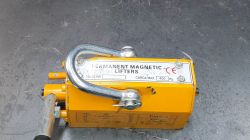 .
.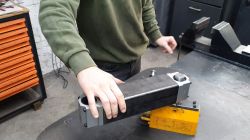 .
. .
.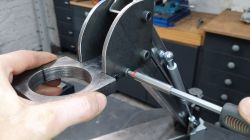 .
.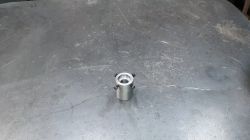
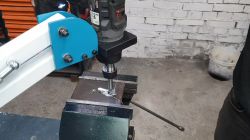 .
. .
. .
. .
. .
.
 .
.


Comments
Nice video of the build. I have a feeling that this arm would even manage this screwdriver together with the operator. [Read more]
I generally like the design, only these linear bearings, as the name suggests are not suitable for the kind of work you are doing. Rotation instead of feed along the shaft. I've used smaller ones and they... [Read more]
Beautiful construction. And you can see the super "balanced" forces needed to position the "head" in the right place. . With his wife and children on his lap. :D Robust construction. . And this... [Read more]
Elegant design. In case the unit has to work hard, you can possibly remove the bearings from the housings and insert 30x45 bushings there as pan. If you don't have time to do the work, you can buy some... [Read more]
I don't know what you're getting at with this corom... To quote my own statement from about a year ago. I know two meanings of the word and neither has anything to do with drills. 1. koromyslo - a carrier,... [Read more]
. I see a similarity here - the counterweight I used to fully control the pressure of the drill. You can't see it in the photo, but there is a double-sided lever (double-armed), the weight of the linear... [Read more]
Years ago I got a "column tapping machine" from a friend, unfortunately it later went to scrap, but in general I remember the construction, the head (something like an ordinary chuck for a column drill)... [Read more]
I think such devices are still produced as threading heads, as well as for fine drilling. Maybe I can find cross-section drawings of the construction. There's a satellite gearbox and something like a... [Read more]
For threading blind holes and deep holes I make my apologies with a screwdriver She 'buzzes' a bit but has an adjustable clutch so I attach her to the Koromysl crossbeam. I don't have to listen to music... [Read more]
Congratulations, you are in second place in DIY constructions: https://www.elektroda.pl/rtvforum/ranking.php And probably immediately in first place. Respect. If you allow me, I will send you a small... [Read more]
Forgive the layman's question - what is the measure given at the end of the film? [Read more]
. The white one? That's the coolant. [Read more]